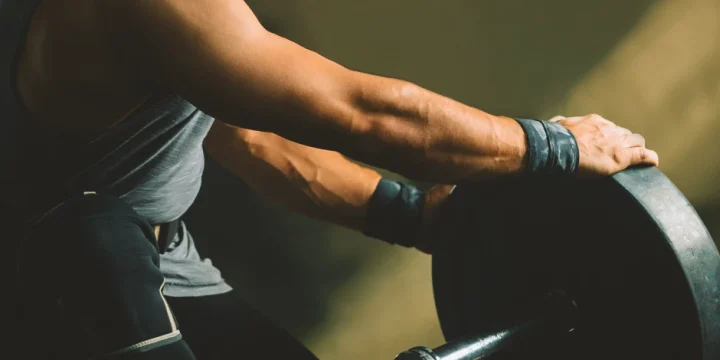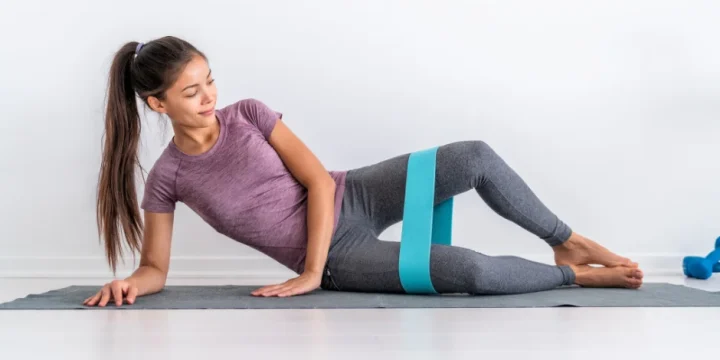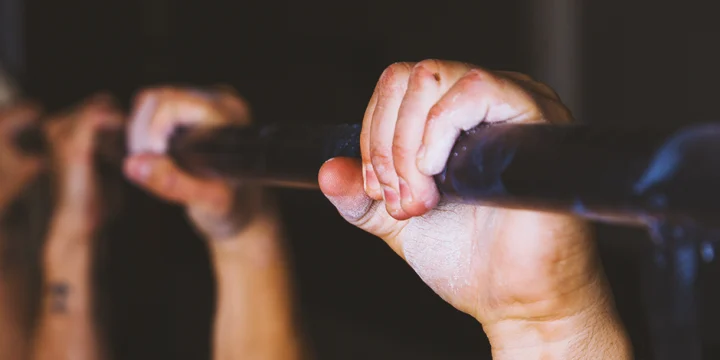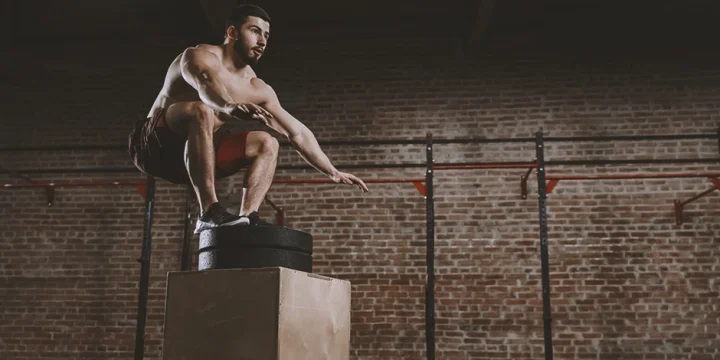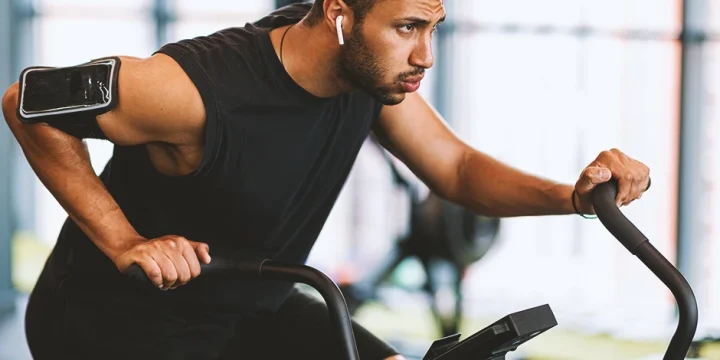As a certified personal trainer with years of hands-on experience, I've witnessed firsthand the transformative power of battle ropes. Not only do they help in maintaining lean muscle mass, but they also build a robust cardiovascular and respiratory system.
Through my journey, I've spent countless hours diving deep into research and practical application, identifying the key benefits that make battle ropes a game-changer in fitness routines.
In this article, I'll share these insights, guiding you through each significant benefit of battle rope exercises. My goal is to empower you with the knowledge and strategies to harness these benefits efficiently, ensuring you can experience the same remarkable results in your fitness journey.
Quick Summary
- Benefits of battle ropes include a full-body workout, enhanced fat burning, and increased muscle-building, while being portable and low-impact on joints.
- They provide a combined upper and lower-body workout, simultaneously activating both regions to maximize oxygen consumption and improve aerobic capacity.
- Incorporating at least two weekly battle rope sessions can significantly improve cardiovascular and cardiorespiratory functions.
- Battle ropes are highly effective for athletes in endurance sports, notably enhancing upper body lactic acid threshold - a vital aspect for sustained high-intensity performance.
15 Battle Ropes Benefits

1. Full Body Workout
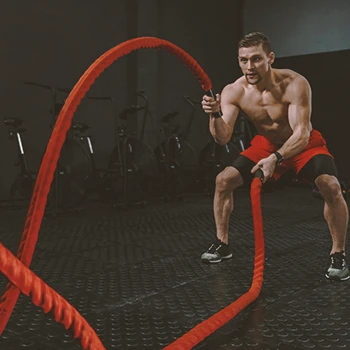
Battle ropes are excellent for providing a full-body workout. They effectively activate both upper and lower body muscles to ensure maximal effort and energy spent.
They are excellent for beginners who must start with a full-body workout since split and the rest of the methods are reserved for more experienced trainees.
In my experience, battle ropes have been a game-changer for full-body workouts. Just last week, I guided a beginner through a session, incorporating lower body movements like kneeling and standing up, which really helped activate all muscle groups.
This is why battle ropes are such a good representative of hybrid training. They don’t just exercise all muscles of your body but also multiple energy systems, such as aerobic, glycolytic, and creatine phosphate.
2. Adaptable
Battle ropes are highly adaptable. You can place them in any room of your house or home gym setup as long as you have enough free space length-wise.
You can also easily store them since they can be bent easily.
In addition, it is very easy to lower or increase the resistance of overall battle rope training by placing your hands on different lengths of battle ropes.
For example, the closer you put your hands toward the anchor point of the battle ropes, the easier the exercise will be.
This is because you will lift less battle rope weight compared to when exercising with battle ropes at full length.
3. Great for Burning Fat
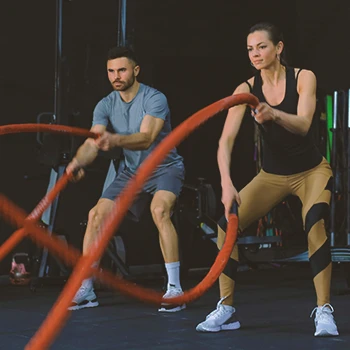
Battle ropes are a piece of excellent gym equipment for burning fat. Burning fat is closely tied to our aerobic system, and battle ropes are perfect for improving cardiorespiratory functioning.
The best way to burn fat with battle ropes is to perform all exercises for a prolonged period and aim to stay in the aerobic zone between 35% and 60% of your VO2 max. This will ensure the most significant amount of fat is burned because our bodies use oxygen to break down fats and create energy.
The higher the intensity of the battle rope exercise, the more you will use carbohydrates or glycogen to create energy, which doesn’t burn fat.
So, to foster the best cardiovascular and fat-burning effects of the exercise, ensure picking lighter battle ropes so you can exercise for a prolonged period.
I've seen remarkable fat-burning results with battle ropes in my clients. One client, in particular, focused on staying in the aerobic zone during battle rope exercises and saw significant fat loss over a few months.
4. Useful for Building Muscle
Battle ropes are great for muscle-building workouts and increasing your muscular endurance.
The heavier the battle ropes, the more muscles you will build over time. This is why it is crucial to choose heavy ropes if your primary goal is to build muscles.
However, picking moderate-weight ropes might be the best option if your main goal is to build muscular endurance.
Keep in mind that progressive overload should be incorporated into the muscle-building program whenever possible, and that’s why it is more useful to have heavier battle ropes.
Also, battle ropes will primarily build your upper body muscles. Still, you can incorporate lower body movements such as jumping, kneeling/getting up to ensure every body muscle is activated.
5. Portable

Battle ropes are highly portable. However, lighter ropes are always easier to move than heavy ones, and the length of the ropes also plays a significant role.
Most people can lift and carry heavy battle ropes independently without help. However, some extremely heavy battle ropes are on the market today, so I advise you to be cautious before picking and purchasing them for the first time.
For your first battle ropes, you want either light or moderate weight, which is easily moved around and doesn’t affect your exercise technique.
If you are a beginner, always start with lighter and shorter ropes, so you can later progress toward heavier ones with more strength and muscle-building potential.
Related Article: The Best Portable Home Gym Equipment
6. Low Impact Muscle Building
One of many reasons you should consider battle ropes if you experience joint problems from sports or age is because they are super low impact.
Many low-impact cardio machines offer great cardiovascular benefits but are costly, not portable, and take up a significant amount of space.
With a fraction of the price of this cardio machine, you can experience all the cardio-related benefits and still not hurt your joints.
However, to ensure your ropes have the lowest impact on your joints possible, pick lighter ones initially. There is a big chance your wrist joint will hurt at the beginning of your battle rope training if you pick a heavy rope.
I've recommended battle ropes to clients with joint issues, and the results are always positive. Just recently, a client with knee problems started using lighter ropes, and they've been able to exercise pain-free while still getting a great workout.
7. Enhanced Athletic Performance
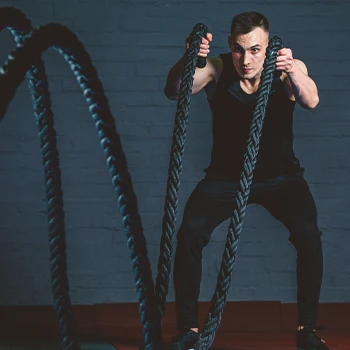
Battle ropes are an excellent choice for all sorts of athletes, especially those participating in martial arts and combat sports.
For example, MMA (mixed martial arts) athletes and boxers can experience great benefits from using battle ropes to condition their bodies before the fight. Battle ropes will ensure those athletes build upper-body muscular endurance without losing strength or making them slower.
However, proper programming techniques, rest intervals, and recovery is needed to get the most out of these workouts and ensure athletes achieve maximal performance without injury.
High-intensity interval training with battle ropes is often used as the secondary means of conditioning in martial arts and combat sports.
"Conditioning circuits aren’t just for CrossFitters. A lot of commercial gyms are realizing the raw appeal of all-out effort. Tools like prowlers, medicine balls, and particularly battle ropes aren’t just available in specialty gyms. You can find them in a lot of locations — and for good reason."
- Eric Bugera, Certified Personal Trainer
8. Great for Mobility and Stability
By performing moderate to high-intensity exercises, battle ropes will improve your shoulder mobility and stability.
One of my clients struggled with shoulder mobility. After regular battle rope sessions focusing on unilateral waves, we've seen a notable improvement in their range of motion.
Battle ropes will force your body to be stable when performing unilateral or bilateral waves exercise. In addition, your core musculature and other body stabilizers will further develop due to strenuous battle rope activity. Mobility-wise, you will develop shoulders and hips mostly.
When you perform jumping slams, you must bend your torso significantly lower, which will stretch your lower body's posterior chain muscles, such as the glutes and hamstrings.
This can improve your squat depth and prevent wear and tear in your posterior chain musculature.
Related Article: The Best Mobility Exercises
9. Works Multiple Muscles Groups

Battle ropes activate multiple muscle groups at once. This is why some people classify them as compound exercises, even though they are primarily cardio and muscular endurance exercises.
You can effectively use battle ropes to warm up since they activate all major upper-body muscles and even some lower-body muscles if you slightly modify the exercises.
You can create entire battle rope sessions devoted to improving your whole-body conditioning and cardiorespiratory system by choosing battle rope exercises that activate both the lower and upper body.
For example, jumping slams is a great exercise targeting both your upper and lower body muscles.
But it isn’t the best exercise to use for prolonged periods since it is plyometric and will significantly impact your joints. Instead, you may choose something along the lines of alternating waves with kneeling and standing-up motions.
This is more sustainable, allowing for better cardiorespiratory benefits and a prolonged workout.
10. Improved Cardiorespiratory Fitness
You can improve your cardiovascular and cardiorespiratory functions by incorporating at least two weekly battle rope sessions [1]. I've seen cardiorespiratory fitness improvements in one client who increased their VO2 max noticeably after a few months of following this routine.
You can choose to perform battle ropes with different intensities, rest intervals, frequency, and resistance, but one thing should always be kept in mind.
The more the activity lasts, the more oxygen you will use to form adenosine triphosphate. Which is the main energy currency of your body.
However, if you seek to improve your overall aerobic capacity and raise your aerobic threshold beyond your current status, you must exercise between the aerobic and anaerobic zones.
Here are aerobic and anaerobic zones according to different experiences:
- Beginner - Between 35% and 60% of VO2 max
- Intermediate - Between 50% and 70% of VO2 max
- Advanced - Between 60% and 80% of VO2 max
11. Lots of Moves to Choose From
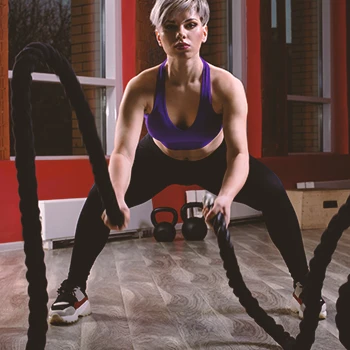
There are plenty of battle rope moves to choose from to design a high-quality endurance or cardiorespiratory workout.
You can switch between bilateral and unilateral battle rope variations, meaning you should perform them with both hands and with only one hand simultaneously.
Also, you can incorporate lower body movements such as kneeling and standing up, jumping, performing side lunges, or similar to further diversify your workouts.
The best cardiorespiratory benefits are seen when both upper and lower body movements are combined in a single exercise.
12. Great for Balance and Coordination
A battle rope workout will greatly increase your balance and coordination by requiring you to stabilize your core with abdominal and hip muscles. Also, plenty of battle ropes exercise variations can introduce new movements to your system and allow coordination to develop.
I've seen remarkable improvements in balance and coordination in my clients. One of them, who initially struggled with stability, now excels at complex battle rope exercises, which has boosted their overall athletic performance.
Even though coordination heavily depends on IQ or general intelligence, it can still be exercised by constantly introducing new movements to your body.
However, you should never proceed to another battle rope exercise before you at least learn the basics and fundamentals of the first one. You can confuse your brain and form bad exercise stereotypes, increasing your chance of injury and hindering your performance.
13. Helps With Avoiding a Plateau
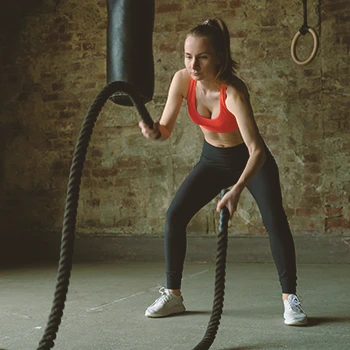
Battle ropes offer a diverse solution to avoid workout plateaus. They encompass the benefits of cardio and muscular endurance exercises. To maximize these advantages, diversify your battle rope routine with both unilateral and bilateral variations, engaging both upper and lower body simultaneously. Incorporate hybrid exercises like rope slams and bilateral rope waves.
Note that combining plyometrics with battle ropes can be taxing, so maintain proper programming, allowing adequate rest and recovery between sets and sessions to sustain performance and avoid overexertion.
14. Unlikely to Sustain an Injury
It is very hard to get injured when performing battle rope exercises. They are extremely low-impact if performed with appropriate rope weight and can greatly benefit your muscular system.
However, the most important thing is choosing the proper battle rope weight since you can easily hurt your wrists and shoulder if you pick too heavy.
In my years of training clients with battle ropes, injury occurrences have been extremely rare. I always start beginners with lighter ropes to ensure safety and gradually build up the intensity.
15. Improved upper body lactic acid threshold
Battle ropes are highly effective in enhancing the upper body's lactic acid threshold, a key factor for athletes in endurance-demanding sports. Onnit Academy underscores this advantage, especially in training MMA fighters, who are expected to sustain intense rope exercises for prolonged periods [2].
One athlete I trained saw notable improvements in their endurance and overall athletic performance after incorporating battle rope sessions.
This focus on upper body conditioning is a distinct departure from the usual lower body-focused training like running or climbing. It not only aids in building endurance but also significantly contributes to overall athletic performance, benefiting other lifts and activities outside the gym.
This makes battle ropes an invaluable tool in an athlete's training arsenal, offering benefits that extend well beyond traditional conditioning methods.
3 Exercises to Try

Here are the best 3 battle rope exercises to try.
"Battle ropes provide a high-intensity, low-impact workout that will challenge your endurance, conditioning, and grip strength in a joint-friendly fashion. Here, we’ll go into the best battle rope exercises, the benefits of using battle ropes in your workouts, and programming suggestions to teach you the literal ropes."
- Shane McLean, Certified Personal Trainer
1. Bilateral Waves
Bilateral waves are the fundamental battle rope exercises performed with both hands and mimic the movement of dropping the ball on the floor.
How to Perform Bilateral Waves:
- Set the battle rope on the anchor point and stretch it to its full length. If you have a heavy battle rope, hold them at 3 quarters or even closer to the anchor point to make the resistance lessened and the exercise easier.
- Hold the ends of the ropes with both your hands.
- Assume a standing stance slightly wider than shoulder-width apart, knees slightly bent, and toes slightly pointing outward.
- Start the exercise by performing bilateral waves simultaneously with both your hands by flexing your shoulders and then starting to extend them when you achieve the top portion of the movement.
- Repeat for a desired time, depending on your training goal.
2. Unilateral Waves

Unilateral waves are the same exercise as the previous one but performed with one hand at a time.
How to Perform Unilateral Waves:
- Set the battle rope as in the previous exercise and hold one end with your right hand.
- Assume a standing position with the feet shoulder-width apart and feet pointing slightly outward.
- Slightly bend your knees and keep them fixed during the whole exercise.
- Start the exercise by raising the battle rope towards the floor by flexing your right shoulder.
- When you reach the top position, reverse the motion by slightly extending your shoulder downward.
- When you reach the bottom position, repeat the same process for the desired time based on your training goals.
3. Rope Slams
Rope slams are the most athletic and the hardest exercise of all three. It will challenge your conditioning, hip explosive strength, and muscle endurance.
How to Perform Rope Slams:
- Set the battle ropes as in the previous two exercises and ensure they are placed on the floor at full length.
- Stand at the end of the ropes and take each end in one of your hands, like in the first battle rope exercise.
- Assume a standing position with your feet slightly wider than shoulder-width apart and your toes pointing slightly outward.
- Slightly bend your knees and keep that position during the entire movement.
- Start the exercise by slamming the ropes on the floor by raising them towards the ceiling and forcefully dropping them towards the ground.
- Repeat this process for the desired time based on your workout goals.
How to Get the Most Out of Battle Ropes?
To get the most out of the battle rope training, you must follow some strict principles like every other body workout.
- Progressive overload - increasing external resistance, number of reps, sets, or overall training volume for each following workout [3]. Progressive overload has been positively linked and correlated with muscular hypertrophy, which is necessary to initiate proper muscle growth [4].
- Rest - Also, you shouldn’t forget to include enough rest between workouts. The recommended rest is between 48 and 72 hours before exercising the same muscle group again [5]. Remember to closely monitor your body for signs of overtraining and excessive fatigue since that can significantly decrease your overall performance and hinder your progress towards achieving benefits from the best battle rope exercises [6].
- Protein intake - Lastly, since battle ropes tend to make you lose weight, you should ensure enough protein intake to preserve and avoid muscle loss during training [7]. The recommended daily protein intake is around 1g per pound of body weight.
"Battle ropes go way beyond alternating waves. You can use them to improve rotational and multiplanar strength and stability, scapular health, force production, and if you control your breathing and keep the intensity low, they can even be used as a decompression tool to help the body relax."
- Nick English, Certified Personal Trainer
FAQs
Do Battle Ropes Burn Belly Fat?
Battle ropes burn belly fat. However, local fat burning is a myth, and you can only burn fat across your whole body if you exercise in the proper aerobic zone, which is between 35% and 60% of your VO2 max.
What Happens if You Do Battle Ropes Everyday?
You will increase your stamina, improve cardiovascular health, and build muscle endurance by doing daily battle ropes.
The benefits of battle ropes are numerous, but the most important is the ability to provide a full-body workout that targets multiple muscle groups and builds upper-body strength.
Are Battle Ropes Better Than Running?
It depends if battle ropes are better than running. A battle rope workout is better for muscular endurance, and running is better for improving cardiovascular and respiratory capacity due to activating more larger muscle groups.
References:
- https://pubmed.ncbi.nlm.nih.gov/29847529/
- https://www.onnit.com/academy/beginners-guide-to-battle-ropes/
- https://www.ncbi.nlm.nih.gov/pmc/articles/PMC4215195/
- https://www.ncbi.nlm.nih.gov/pmc/articles/PMC6950543/
- https://www.ncbi.nlm.nih.gov/pmc/articles/PMC6719818/
- https://www.ncbi.nlm.nih.gov/pmc/articles/PMC3435910/
- https://pubmed.ncbi.nlm.nih.gov/26797090/
About The Author
You May Also Like
